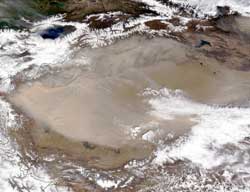If an asteroid crashes into the Earth, it is likely to splash down somewhere in the oceans that cover 70 percent of the planet’s surface. Huge tsunami waves, spreading out from the impact site like the ripples from a rock tossed into a pond, would inundate heavily populated coastal areas. A computer simulation of an asteroid impact tsunami developed by scientists at the University of California, Santa Cruz, shows waves as high as 400 feet sweeping onto the Atlantic Coast of the United States.
The old song, asking rain to “go away” and “come again another day,” may get even older for people who live in large coastal cities, according to new NASA-funded research. According to the study, urban heat islands, created from pavement and buildings in big coastal cities like Houston, cause warm air to rise and interact with sea breezes to create heavier and more frequent rainfall in and downwind of the cities. Analysis of Houston-area rain-gauge data, both prior to and since urbanization,
It has long been known that tropical climate – by redistributing vast amounts of solar energy through welling hot air and the formation of towering cumulous clouds – influences weather in other parts of the world.
It remains unclear, however, how much the tropics can be affected by higher latitudes.
Now, with the help of a sophisticated computer model, scientists at the University of Wisconsin-Madison have shown that vast atmospheric “bridges” and oceanic “tunnels,” created by overturn
The world’s oceans hold the key to our future electricity needs. And their potential for producing power has yet to be fully exploited in terms of sustainable energy. The EUREKA WWEC project team hopes to bring exploitation of this renewable energy source a big step forward.
“We’ve developed a device that generates energy from the sea as easily as a wind turbine would do on land,” explains William Dick, managing director of the Irish company Wavebob that led the project. “There’s an awful lo

Dust from China’s Takla-Makan desert traveled more than 20,000 kilometers [12,000 miles] in about two weeks, crossing the Pacific Ocean, North America, and the Atlantic Ocean, before settling atop the French Alps. Chinese dust plumes had been known to reach North America and even Greenland, but had never before been reported in Europe.
An international team of scientists, using atmospheric computer models, studied dust that traveled the globe from February 25 to March 7, 1990. Their findin
90 % of all large fish including tuna, marlin, swordfish, sharks, cod and halibut are gone – leading scientists say need to attempt restoration on a global scale is urgent
The cover story of the May 15th issue of the international journal Nature reveals that we have only 10% of all large fish– both open ocean species including tuna, swordfish, marlin and the large groundfish such as cod, halibut, skates and flounder– left in the sea. Most strikingly, the study shows that industrial